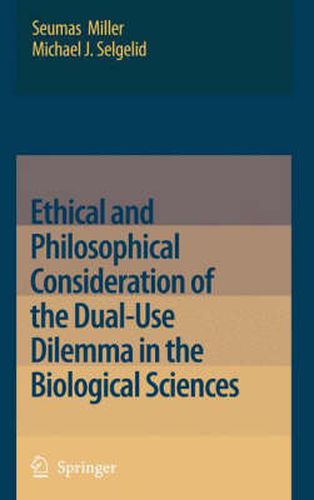Readings Newsletter
Become a Readings Member to make your shopping experience even easier.
Sign in or sign up for free!
You’re not far away from qualifying for FREE standard shipping within Australia
You’ve qualified for FREE standard shipping within Australia
The cart is loading…






This title is printed to order. This book may have been self-published. If so, we cannot guarantee the quality of the content. In the main most books will have gone through the editing process however some may not. We therefore suggest that you be aware of this before ordering this book. If in doubt check either the author or publisher’s details as we are unable to accept any returns unless they are faulty. Please contact us if you have any questions.
What Is the Dual-Use Dilemma? The so-called dual-use dilemma arises in the context of research in the biological and other sciences as a consequence of the fact that one and the same piece of sci- tific research sometimes has the potential to be used for harm as well as for good. A dual-use dilemma is an ethical dilemma, and an ethical dilemma for the researcher (and for those who have the power or authority to assist or impede the researcher’s work, e. g. , governments). It is an ethical dilemma since it is about promoting good in the context of the potential for also causing harm, e. g. , the p- motion of health in the context of providing the wherewithal for the killing of in- cents. It is an ethical dilemma for the researcher not because he or she is aiming at anything other than a good outcome; typically, the researcher intends no harm, but only good. Rather, the dilemma arises for the researcher because of the potential actions of others. Malevolent non-researchers might steal dangerous biological agents produced by the researcher; alternatively, other researchers-or at least their governments or leadership-might use the results of the original researcher’s work for malevolent purposes. The malevolent purposes in question include bioterrorism, biowarfare and blackmail for financial gain.
$9.00 standard shipping within Australia
FREE standard shipping within Australia for orders over $100.00
Express & International shipping calculated at checkout
This title is printed to order. This book may have been self-published. If so, we cannot guarantee the quality of the content. In the main most books will have gone through the editing process however some may not. We therefore suggest that you be aware of this before ordering this book. If in doubt check either the author or publisher’s details as we are unable to accept any returns unless they are faulty. Please contact us if you have any questions.
What Is the Dual-Use Dilemma? The so-called dual-use dilemma arises in the context of research in the biological and other sciences as a consequence of the fact that one and the same piece of sci- tific research sometimes has the potential to be used for harm as well as for good. A dual-use dilemma is an ethical dilemma, and an ethical dilemma for the researcher (and for those who have the power or authority to assist or impede the researcher’s work, e. g. , governments). It is an ethical dilemma since it is about promoting good in the context of the potential for also causing harm, e. g. , the p- motion of health in the context of providing the wherewithal for the killing of in- cents. It is an ethical dilemma for the researcher not because he or she is aiming at anything other than a good outcome; typically, the researcher intends no harm, but only good. Rather, the dilemma arises for the researcher because of the potential actions of others. Malevolent non-researchers might steal dangerous biological agents produced by the researcher; alternatively, other researchers-or at least their governments or leadership-might use the results of the original researcher’s work for malevolent purposes. The malevolent purposes in question include bioterrorism, biowarfare and blackmail for financial gain.